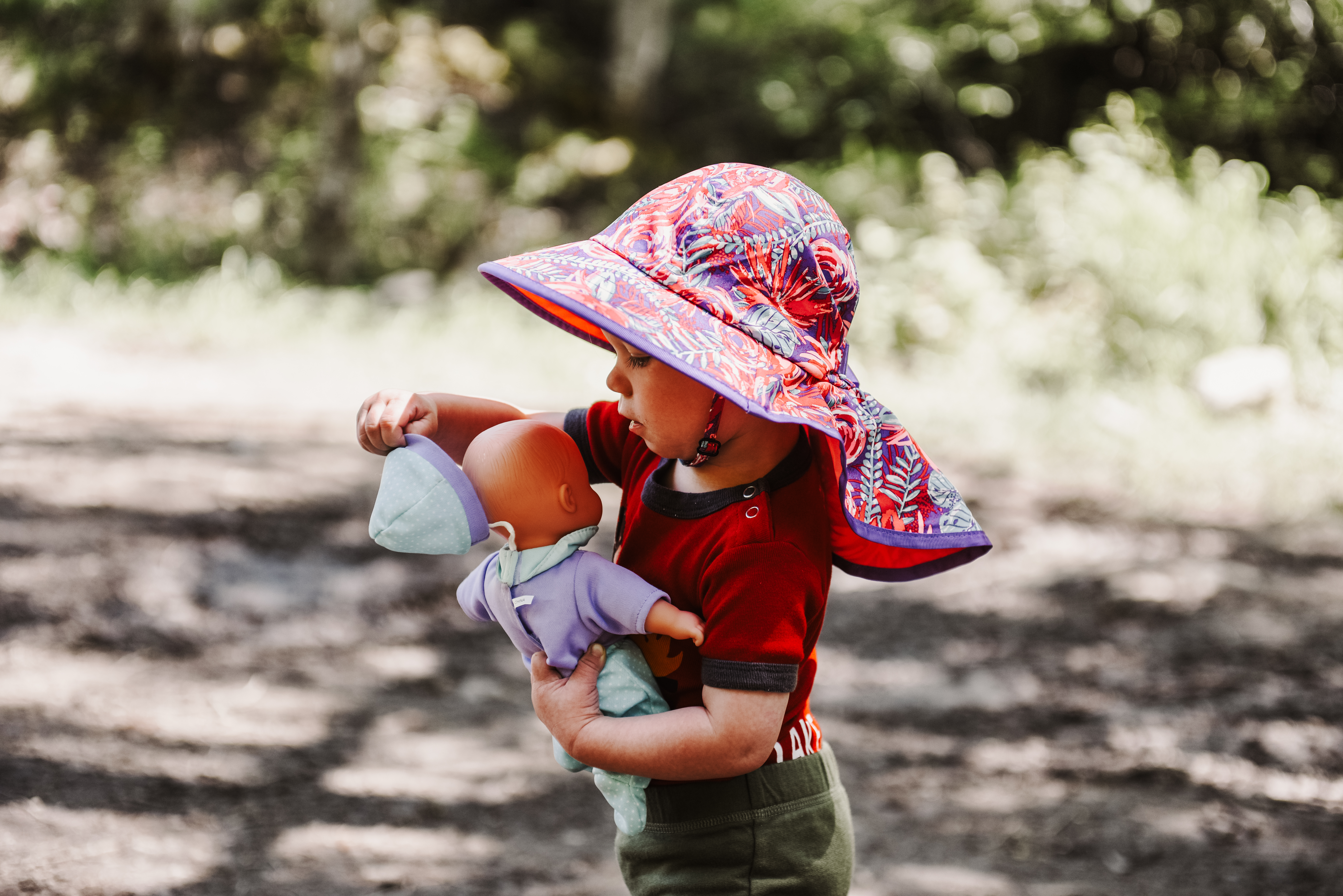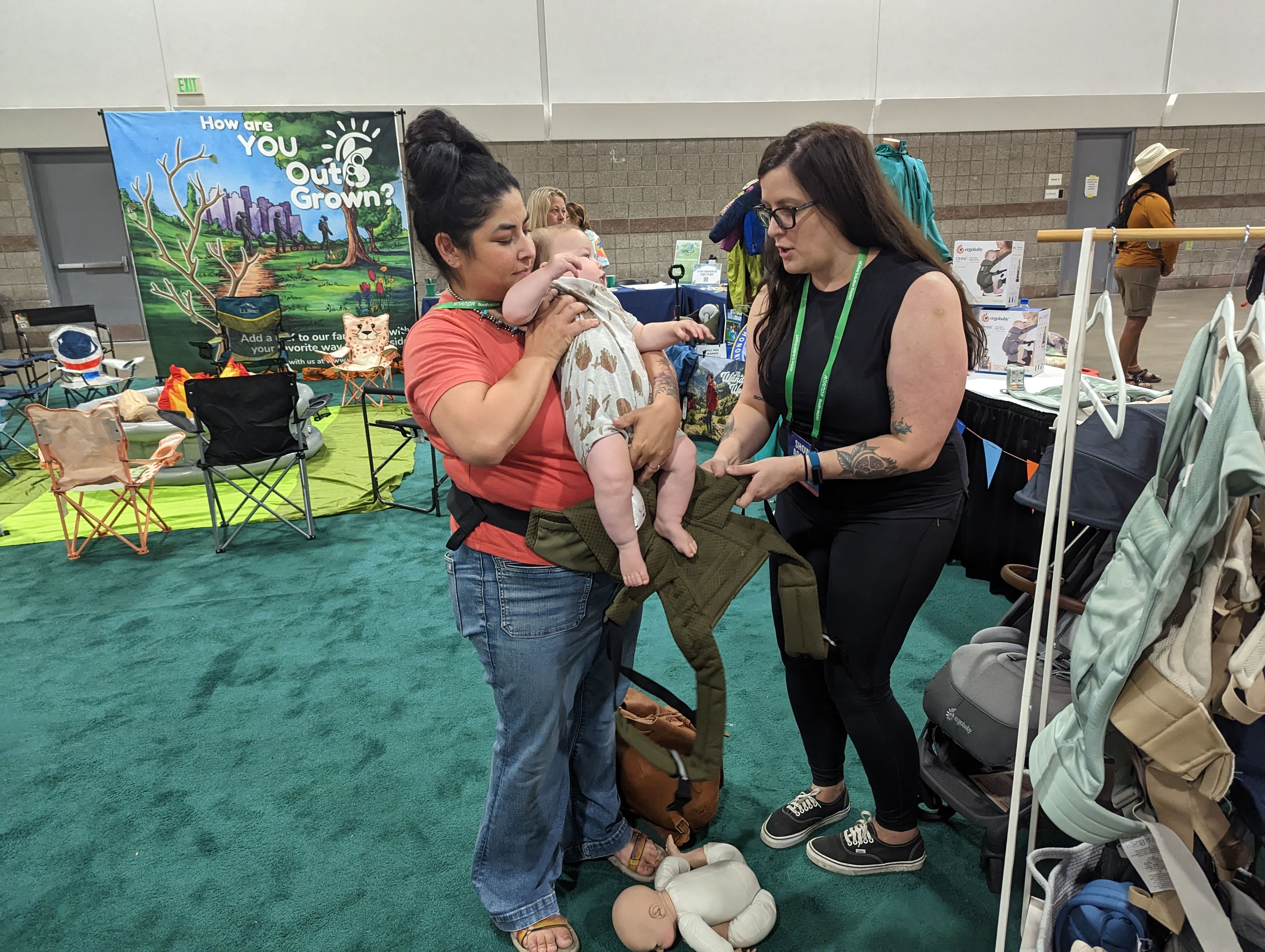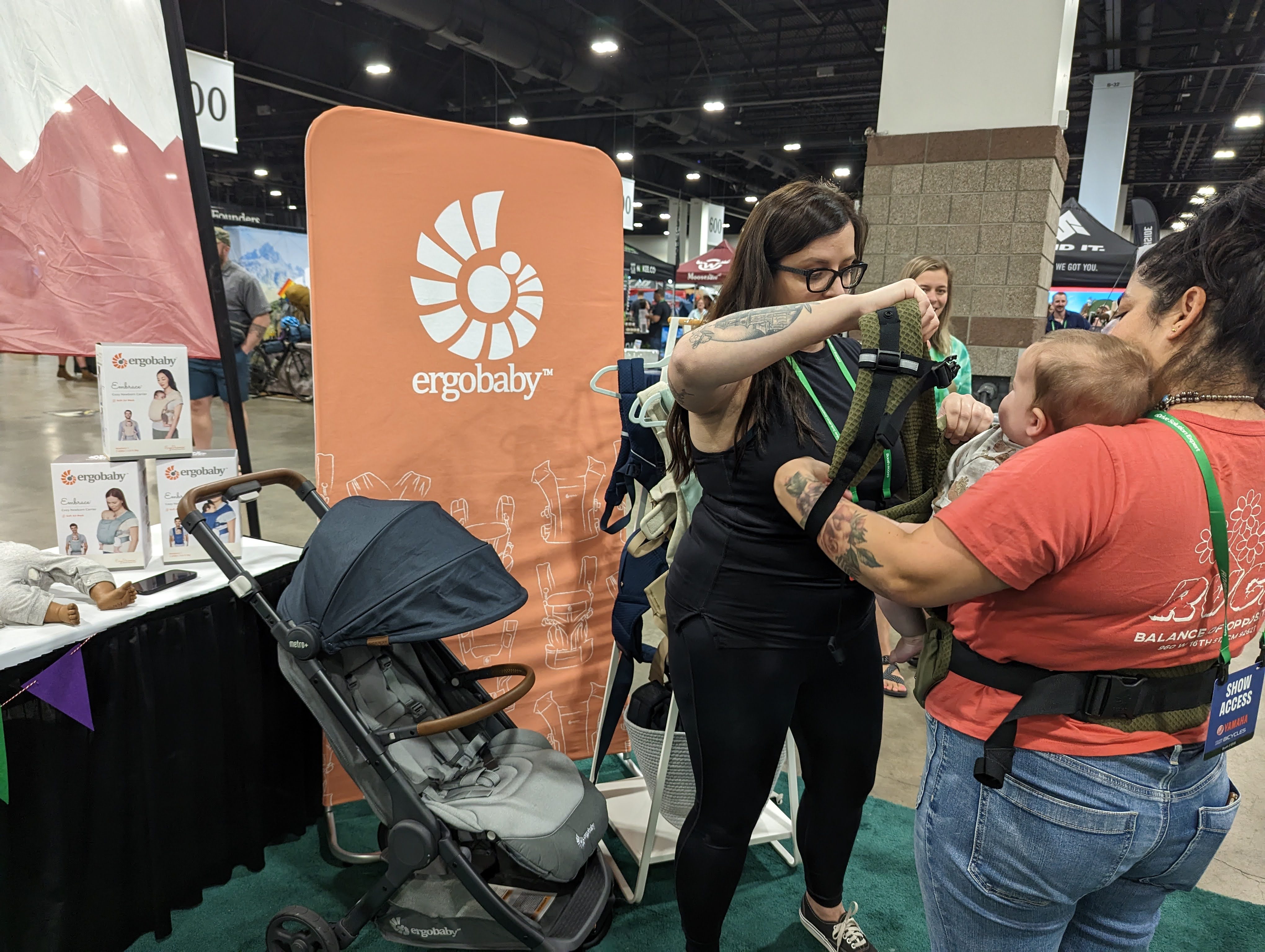Enjoying Outdoor Summer Adventures with Little Ones
CREATED IN PARTNERSHIP WITH OUR FRIENDS AT ERGOBABY
Don’t let the higher temperatures keep you inside this summer! Even with the littlest additions to your family, there are ways to stay safe while exploring in warmer weather. With extra preparation (and maybe a few new gear items), your family can stay cool while enjoying those long summer days. Check out these tips for what to wear, when and where to go, gear to consider, and fun activities that will surely put a smile on everyone’s face.
What to Wear
You may think less clothing is best in warm weather, but you may do more harm than good going this route. The radiation from the sun is most potent in summer since the earth is tilting towards the sun in these months. That means the risk of damage to your skin and eyes is at its highest. Consider these clothing options to cover up the skin (especially sensitive baby skin!) while keeping cool.
Sun-Protective Clothing
Avoid the sunscreen battle by purchasing sun-protective clothing. This clothing, whether a shirt, pants, etc., offers sun protection while keeping the wearer cool. Look for lightweight options with a UPF rating 50+ for maximum sun protection.
Sun Hats
Keep those little faces and necks protected with a quality sun hat. The wider the brim, the better protection from the sun’s damaging UV rays. Since the face, ears, and neck are three of the most common areas that develop skin cancer, this article of clothing is essential, especially for little ones.

Sunglasses
Who doesn’t love a cool pair of shades? They also happen to protect your eyes from damage. Just be sure to look for ones with 100% UV protection to protect those developing eyes (especially if your kiddos have a habit of looking right at the sun after you tell them not to).
These clothing items will help tremendously, but be sure to still use sunscreen on any exposed skin for anyone 6 months of age and older (for younger babies, speak to your pediatrician for recommendations on skin protection). Look for a water-resistant broad-spectrum sunscreen with an SPF rating of 30 or higher. Check out this post for more information on choosing a sunscreen and staying safe in the sun.
When and Where to Go
When adventuring in the heat, try to aim for early-mid morning or later in the afternoon. The amount of solar radiation hitting the earth is highest between 11:00 am – 3:00 pm. During this time, the temperatures rise, and there is a higher risk of sun damage (especially for sensitive kid skin!). You can also check the UV index on most weather apps to determine how high it is for your location at any time (read this blog post for more information).
If you plan to hit the trail or the park, seek options with plenty of shade. This not only makes for a cooler adventure, but it also cuts down on the amount of ultraviolet rays that reach you. Another great option is to choose a trail or location with a water feature. This could be a beach, a creek, or a splash pad. This will help everyone cool off and enjoy the rest of the adventure.
Gear to Consider
While we always recommend bringing at the 10 Essentials whenever hiking or adventuring away from civilization, here are some other items to consider (or take special note of) while exploring in the heat.
Hydration and Snacks
While water and extra food are part of the 10 essentials, I wanted to note them here because they become even more essential in high temperatures. Generally speaking, during moderate exercise in mild temperatures, an average adult should drink around half a liter of water per hour. This number can double a liter per hour during especially hot and humid outings! Kids old enough to drink water should drink roughly half as much as their adult caregivers.
Drinking water isn’t enough when you are sweating in the hot temperatures. You also need to replenish the electrolytes and nutrients (such as sodium and potassium) lost through sweat. Check out this article for tips on how to pack trail snacks for summer hikes.
Child Carrier
So many child carriers are on the market, and they are not created equal, especially when carrying a young one in the heat! For summertime babywearing, seek a carrier with lightweight, breathable fabric without sacrificing support.
We love the Omni Breeze from Ergobaby because it’s highly breathable and allows you to carry your little one from newborn to toddler in various positions with no extra insert needed! If you’re looking for an option with a bit more stretch while staying supportive and ultra-lightweight, Ergobaby also has the super breathable Aerloom Baby Carrier, which is one of the lightest carriers on the market (it’s less than 1.5 pounds!).
Cooling Accessories
If your adventure takes you into the heat for a longer period of time, consider adding some cooling accessories to your gear list. This could be cooling towels (such as Frogg Toggs), portable fans that attach to your stroller or carrier, or a handheld mister to keep your family cool. These products promote the evaporation of moisture from your skin, which can help you better regulate your body temperature in hot conditions. This is especially important for little ones since they are less efficient at temperature regulation compared to adults.
Stroller
As temperatures rise, attaching a little portable heater (aka your child) to you may not be the best option. Taking along a stroller can be a lifesaver for both caregiver and child! It provides shade and airflow for your child and makes for a less stifling experience. I generally suggest jogging or all-terrain options for trails, but these strollers aren’t as practical for most other summer adventures.
Instead, seek out a stroller with features that work for you, such as decent storage space, compact folding capabilities, and a sunshade that provides ample protection from the sun. One great option is the Metro Deluxe Stroller from Ergobaby. It is suitable for newborns to preschoolers with its near-flat recline and plush padding. It also folds up super small, making it easy to travel with or store in almost any vehicle. The adjustable handlebar and expandable storage basket make this stroller work for almost anyone and any adventure.
Fun Summer Activity Options
There are so many fun ways to explore the outdoors in summer! Here are some of our favorites that are sure to leave everyone smiling while you make lasting memories:
Seek Out a Water Source
There’s nothing quite as refreshing as playing in the water on a hot summer day. Here are some fun options to keep your family cool while making fun summer memories.
Pool Time – Whether you belong to a local pool or have a small toddler pool in your backyard, pool time is a wonderful way to escape the heat while enjoying the outdoors.
Creeks, Rivers, and Waterfalls – My family absolutely loves hiking to a water source on hot summer days! These could be slow creeks, narrow rivers, or glorious waterfalls to splash in. Splashy fun also makes the hike back more comfortable and bearable.
Splash Pad – Babies and toddlers love sticking their hands and feet in the fountains and features of a splash pad.
Head to the Beach – If you live near a lake or the coast, visiting the beach is an obvious choice for summer fun! Little ones love to build sand castles and stick their toes in the surf while hunting for crabs or shells.
Farmer’s Markets and Festivals
Farmer’s markets are fun to get outside while supporting local farmers and businesses by enjoying local produce and products. Festivals also provide fun entertainment (and rides for some) and delicious, unique food options.
Fruit Picking
Strawberries, blackberries, peaches, oh my! Picking fruit is such a fun experience, no matter your age. Seek a local you-pick farm to see which delicious fruit (or veggie) options grow near you in summer.
Find a Nature Center
Many state, local, regional, and national parks have nature centers on their lands. While each center varies, you can find a nice respite from the heat by exploring what they offer and learning about the local flora and fauna. You can also find more information about local trails and programs offered for families and children by speaking to rangers and staff at the nature center.
Picnics at the Park
Whether the park features a playground, a splash pad, nature trails, or a wide-open field, picnics are a great way to spend time in nature as a family. Pack a cooler or basket with some favorite foods, set out a blanket in a shady spot, and you’re ready to go!
Fly a Kite
There's just something mesmerizing about watching a kite soar through the air. Both of my boys loved watching me fly a kite in the summer breeze. Now they have their own kites to fly and are still mesmerized!
Camping
You may think I’m crazy for suggesting summer camping with little ones, but it’s totally doable! With some extra planning (and a little extra equipment to cool you down), camping in the summer may turn into your favorite adventure yet. Check out this post on how to camp with kids in the summer.
Nature Scavenger Hunt
Who doesn’t love to hunt for nature’s treasures? You can make this a teachable moment for little ones and have them seek out something in every color of the rainbow, or have them practice their numbers by finding 2 leaves, 3 acorns, etc. You can also make them a list of natural items and have them cross them off as they move down the trail. Check out this post for even more nature scavenger hunt ideas.
Geocaching
You can try geocaching if you want to take your treasure hunting further. Simply download the app (aptly named “geocaching”) and input your location to find caches near you. From there, you can click on an option to find the GPS coordinates, clues, difficulty level, etc. Everything can be done straight from your phone (no special equipment required). Just be sure to have a pen handy to sign the register when you find one! Check out this post for more information on geocaching with kids.
Explore the Zoo
Visiting the zoo is usually a big hit with kids of all ages, no matter the season. The great thing about visiting the zoo in summer is that they usually have shops, restaurants, or indoor exhibits along the way so you can take a break from the heat as needed.
What are your favorite ways to explore the outdoors in summer with your family? Let us know in the comments below!
Photos by Deanna Curry and Jessica Carrillo Alatorre
ABOUT OUTGROWN
OutGrown is a 501(c)(3) nonprofit that works to create a world where everyone can enjoy the physical and mental benefits of spending time outside. We are focused on creating opportunities and removing barriers to access so families with babies and young children can take their first steps outside. We believe all families have the right to connect with nature, benefit from spending time outdoors, and be inspired to a lifelong love of nature. Since its grassroots inception in 2013, OutGrown is a growing community of 280,000 families and over 300 volunteer Branch Ambassadors. More information on all of our programs can be found at WeAreOutGrown.org
EDITORS NOTE:
We hope you enjoyed reading this article from OutGrown. We’re working hard to provide our community with content and resources that inform, inspire, and entertain you.
But content is not free. It’s built on the hard work and dedication of writers, editors, and volunteers. We invest in developing premium content to make it easier for families with young children to connect with nature and each other. We do not ask this lightly, but if you can, please contribute and help us extend our reach.
Related Content






Comments